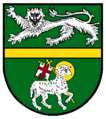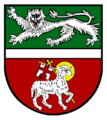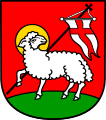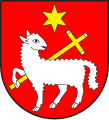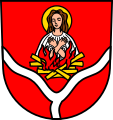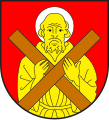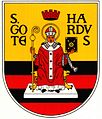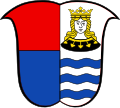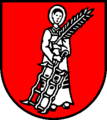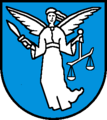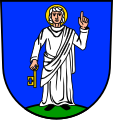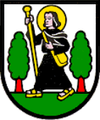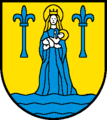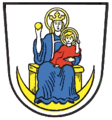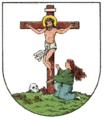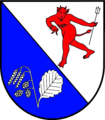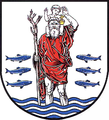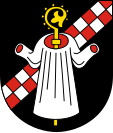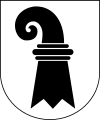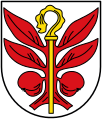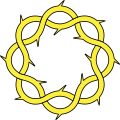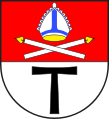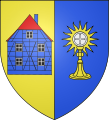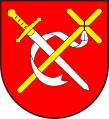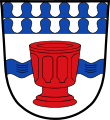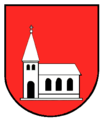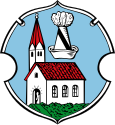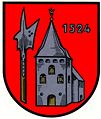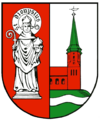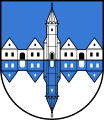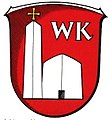Christian symbols in heraldry
Christian symbols in heraldry have found a permanent place in heraldry. In many coats of arms the history of the development of the faith is revealed through the representation of religious things . All of these coats of arms belong to the common figures in heraldry. The crosses are an exception . Crosses that are not free in the shield are heraldic images . Often they are not only part of a shield, but also often have a religious message.
Human figures
In particular, coats of arms with representations of dignitaries ( bishops ), monks or figures of saints stand out. They are often firmly connected with the local history, either giving their name to a local church or just as patron saints for the craftsmen, hikers and fishermen.
Saints are excellent representatives of a religion who are officially canonized after death, especially in the Catholic Church . The preliminary stage to canonization is beatification . The canonization according to the investigation procedure takes place the admission of a deceased into the canon of the saints. People are also honored for having suffered a martyr's death or for a godly life. Saints are understood as intercessors with God . This veneration has been known since about the 2nd century, first for martyrs , and later also for the so-called confessors . The bishops, abbots , monks and also the virgins and the apostles are counted as confessors .
In the case of the saints, the recognition attributes play an important role. Examples of attributes are: Andrew, as Peter's brother, has the St. Andrew's cross named after him and Peter has two keys and the fallen cross as a sign of identification. Martin is shown on horseback and cutting his coat. Martyrs are often assigned the martyr's palm , also represented as a palm frond , as an attribute.
The attributes cannot always be assigned with certainty. Many saints have the same name, but different personalities are hidden behind them. In the calendar, the days are marked with the names of the saints. These name days are arranged according to the date of canonization, birth or death and have entered people's consciousness as small holidays.
gloriole

To distinguish it from other figures, the halo is placed around the head and the mandorla around the whole body . The former is a circle designed to make a radiant impression. It is emblazoned in gold, rarely silver . The mandorla as an almond-shaped halo, the glory , surrounds the whole figure; it has been demonstrable since the 11th century. This form of representation was common with Mary and Christ .
Agnus Dei
The Agnus Dei (German: God's lamb, lamb of God, or Easter lamb ) is a heraldic animal in which the halo is used. He is also known in heraldry as a Christian symbol and a common figure as a heraldic image . A lamb is shown with a foreleg wrapped around a cross. The head, surrounded by a halo or nimbus , is often tilted backwards. The lamb can run right or left. So it is in the city coat of arms or ecclesiastical emblem shown. The lamb carries the victory flag / Easter flag, which is a pole ending in a cross with a silver banner with a red, continuous cross.
left leg raised ( Bennwil )
right leg raised ( Garding )
right leg raised and book ( Debrecen )
John the Baptist with Agnus Dei ( Seßlach ) depicted on a disk
John the Baptist with resting Agnus Dei ( Lützen )
Agnus Dei ( Oberneukirchen )
Nyírbátor ( Bathor )
Szentendre ( Saint Andrä )
The small difference
The lack of a halo is the most significant difference between the Agnus Dei and the sheep . The sheep stands for breeding and keeping in the region. The coat of arms image and the description must match in order to avoid misinterpretation.
Sheep ( Ochtrup )
Lamb bleeds into a chalice ( Nieder-Mörlen )
on the shield , held by a Nassau lion ( Niederseelbach )
the Easter lamb also rests in St. Johann im Pongau
Sheep ( Calvià )
Sheep ( Civitella d'Agliano )
Sheep ( Dravograd )
Sheep ( Latowicz )
Sheep ( Vrin )
Sheep ( Schafhausen )
single sheep ( Schafisheim )
half-shorn sheep Klinski (noble family)
Saints
List of coats of arms with saints
- Annaberg-Buchholz (both sub-towns), Aschaffenburg , Bad Ems , Bad Oldesloe , Bendorf , Bingen am Rhein , former coat of arms of Bobenheim , Boos , Börrstadt , district of Cuxhaven , Dahenfeld , Dannstadt , Dienstadt , Edesheim , Engelstadt , Gotha , Gündelbach , Hallgarten , Hatzenbühl , Helmstedt , Hördt , Iserlohn , Katzenbach , Krefeld , Kruft , Land Hadeln district , Landwürden , Lykershausen , Marne (Holstein) , Martinshöhe , Obersülzen , Ohrdruf , Pfaffen-Schwabenheim , Pleisweiler-Oberhofen , Poppenhausen , Reichenau , Rüdesheim (Nahe) , Rüdesheim am Rhein , Sankt Katharinen , Sankt Martin (Pfalz) , Staßfurt , Trier , Wenden , Werdau , Zella-Mehlis , Zell am Main , Zellertal
List of documented saints
-
Achatius of Armenia , Aegidius , Afra , Alban of Mainz or Alban of England (very similar representation), Alto , Andreas , Anna , Bernhard , Bishop , Blasius , Engel , Gallus , Georg , Mother of God with Baby Jesus , Godehard of Hildesheim ("Gotthard" ) , Hildegard , James , John the Baptist , Johannes , Katharina , Kilian , Korbinian , Laurentius , Leonhard , Madonna , Maria Magdalena , Magnus , Margarethe , Markus , Martin , Mauritius , Maximin , Michael , Mother of God , Nikolaus , Peter , Petrus , Petrus Martyr , Pirmin , Regiswindis , Remigius , Sebastian , St. Valentin , Stephanus , Ulrich , Vitus , Verena , Wendelin
- see attributes of saints
Gallery saints
Martyr Afra
Alban of Mainz or Alban of England holding his severed head in his right hand
Bernhard , raised the rights to an oath
Blaise with two candles and Mary Magdalene with an ointment vessel
Gallus with bear
Gallus with bear
John on a chest bench and with a lamb of God on a golden disc
the bearded head of John the Baptist
John the Evangelist writing his Gospel
Korbinian with the Korbinian Bear
Laurentius with rust and martyr's palm
Margaret of Antioch with a golden hairstyle standing on a green dragon
Mark on a lion
Martin sharing his coat
Maximin , raised the rights to an oath
Nikolaus , holding three golden balls (loaves) in his left hand
Nikolaus , holding three golden balls (loaves) in his left hand
Nicholas with crook, his right hand raised in a blessing
Regiswindis with palm branch
Remigius under a golden canopy
Sebastian with arrows
Ulrich with fish
Verena with a golden comb and a green water jug
Vitus in a golden cauldron
Mother of God and Jesus
Mother of God with baby Jesus
on the right the Mother of God with the child in her arms, on the left Katharina , in the right a lowered sword, a broken red wheel at her feet
Mother of God with baby Jesus
Jesus on the cross
- See also main article: Mother of God and further coats of arms with the Mother of God
Gallery Other religious figures
- Angels are a popular figure as shield holders . In talking coats of arms can often be found, as in the coat of arms of the Engelberg monastery in Switzerland. As a common figure , the angel can also be found in the coat of arms. The depiction of an angel's head, also called a cherub head , is a head with attached wings according to the Jewish and Christian conceptions. This head has two wings, while in heraldry there is also the seraph head . This is multi-leaf.
Mönch (" Münchner Kindl ")
Bishop , possibly Valentin of Raetia
River god with oar and water vessel
The fourteen emergency helpers
The names of the fourteen helpers are:
- Achatius , Blasius , Erasmus , Georg , Pantaleon , Vitus , Aegidius , Dionysius , Cyriak , Christophorus , Margareta , Katharina , Barbara , Eustachius
The following emergency helpers are used as heraldic figures:
Religious symbols
- The miter or inful is heraldically always placed on the right on the upper edge of the shield of the coat of arms. She takes on the role of the crown of rank.
- The bishop 's staff (also shepherd's staff) is placed on the left side on the upper edge of the shield. It is the counterpart to the miter. The long, richly decorated staff is depicted in coats of arms of bishops and archbishops with the spiral outwards and in those of abbots inwards. The ecclesiastical heraldry deals with the peculiarities of the structure of the coat of arms of church dignitaries.
- The Holy Trinity is demonstrated by two over a (2: 1) gold miter. (Commonly used in the coats of arms of English dioceses: Chester in red and Norwich in blue. In the coat of arms of Bristol in black three open gold crowns, in that of Ely in red 2: 1 gold crowns.) An interpretation of the flag of Ethiopia also refers to the Christian one Trinity. According to this, the colors also symbolize the Christian virtues. Green for the Holy Spirit and for hope, yellow for God the Father and for charity and red for the Son and for faith. In Christian teaching, the shamrock is symbolic of the Trinity.
- Tiara with keys in the coat of arms of the Vatican .
- Mandorla as a halo surrounding the whole body. Reserved for Jesus and Mary .
- The palm frond can be found in many coats of arms, including national coats of arms. It is a religious symbol of various religions and also an attribute of saints.
- The Luther rose is a symbol of the Evangelical Lutheran churches and can be found in German and Austrian coats of arms.
- The crown cross as a symbol of diakonia is a rare coat of arms.
- The golden halo with five five-pointed golden stars is the symbol of Johannes Nepomuk , the patron saint of bridges.
- The winged bull is a specialty in heraldry. Here the bull has wings attached at shoulder height. He is the attribute of the Evangelist Luke .
- In heraldry, the lily is interpreted as a sign of the Mother of God. A complete representation is a heart decorated with two lilies and decorated / raised with / by a cross .
- Johannis bowl,
Gallery of religious symbols
Crosier in front of a stylized apple tree
Bible and rosary
Book with cross
floating the golden eye of God
Sword ( Viktor ) and cross staff ( John the Baptist )
Icon of Saint John Nepomuk
Two passion nails , in the middle as part of a bridle
Church in the coat of arms
Tent church in the coat of arms of birch honey food
Church in the coat of arms of Bleibach
Church in the coat of arms of Cappel
Church in the coat of arms of Gelsenkirchen
Church in the coat of arms of Hohenaspe
The Ochsenturm , a former church tower, in the coat of arms of Imsum
Church in the coat of arms of Kirchberg an der Murr
Church in the coat of arms of Mulsum
Church in the coat of arms of Rheindahlen
Church in the Seekirch coat of arms
Dionys Church and Patron in Sittensen
Church throws shadows : Schattendorf
Church in the coat of arms of Tschagguns
Church in the coat of arms of Waldkirch
Church in the coat of arms of Waldkirchen
Church in the coat of arms of Weißkirchen
Church in the coat of arms of Winden in Elztal
Cross and the church flag
There is general information about the cross and special information about the crosses in heraldry . The church flag , especially the Montfort church flag , is widespread.
Scallop
The name scallop goes back to Saint James , the patron saint of pilgrims , whose distinguishing mark is the shell. Therefore, the scallop is also known as the symbol of pilgrims, especially those on the Camino de Santiago . The Christian pilgrims of the Middle Ages used the scallop to draw water.
literature
- ↑ Gert Oswald : Lexicon of Heraldry. VEB Bibliographisches Institut, Leipzig 1984.






